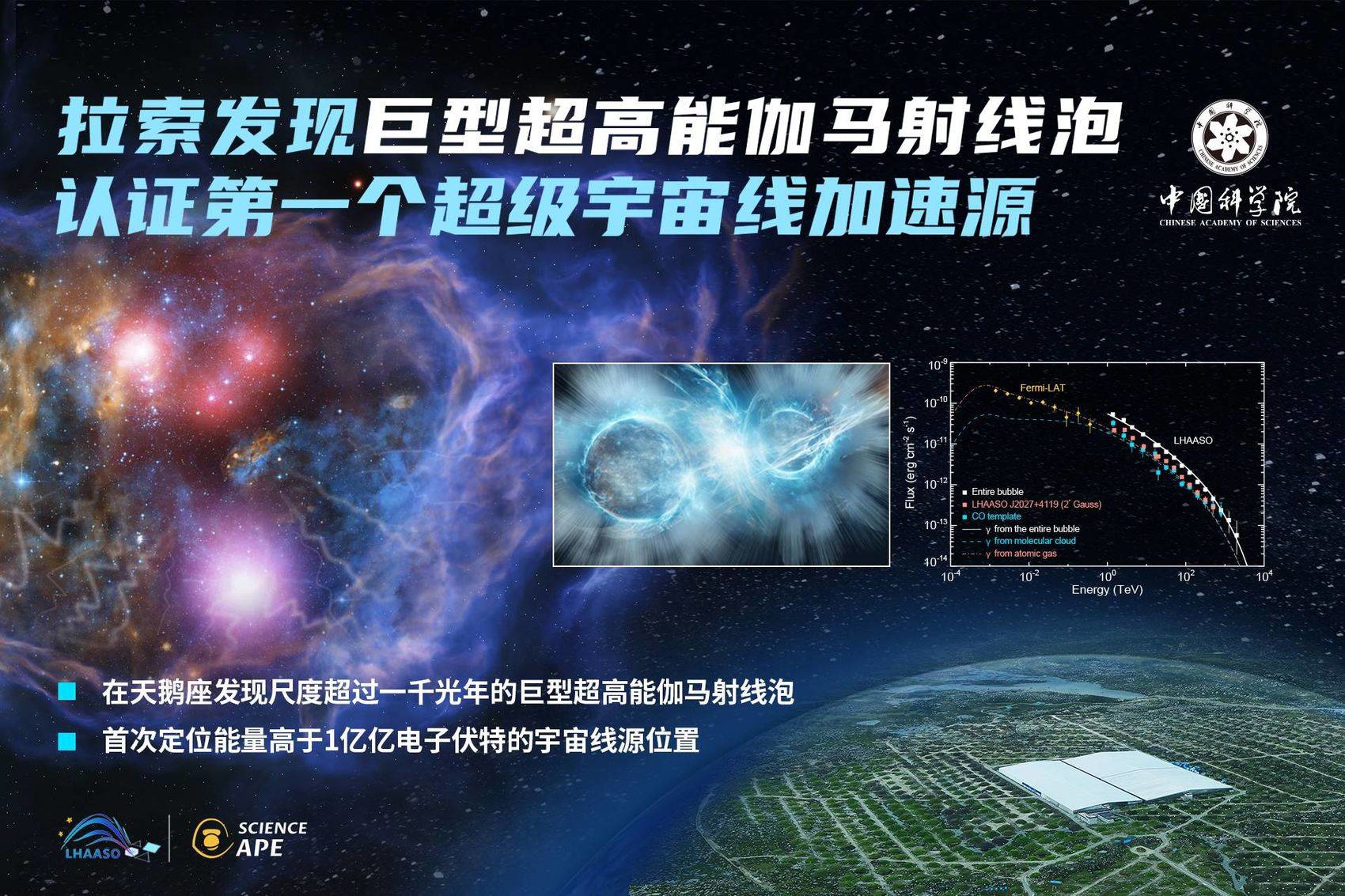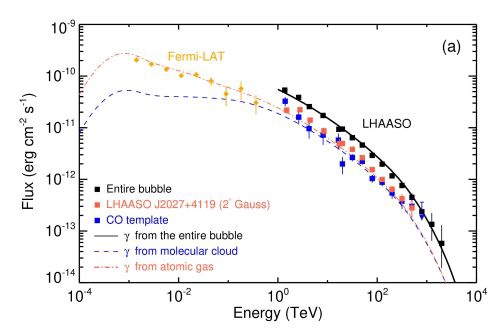LHAASO Discovers Giant Ultra-high-energy Gamma-ray Bubble, Identifying the First Super PeVatron
2024-02-26 by Chinese Academy of Sciences
The Large High Altitude Air Shower Observatory (LHAASO) has discovered a giant ultra-high-energy gamma-ray bubble structure in the Cygnus star-forming region, which is the first time that the originof cosmic rayswith energy higher than 10Peta-Electronvolt(PeV, 1PeV=1015eV)has been discovered. This achievement was published in the form of a cover article inScience Bulletinon Feb. 26. The research was completed by the LHAASO Collaborationled by Prof. CAO Zhen as the spokesperson from the Institute of High Energy Physics of the Chinese Academy of Sciences. Dr. GAO Chuandong, Dr. LI Cong, Prof. LIU Ruoyuand Prof.YANGRuizhiare the co-corresponding authors of the paper.

Cosmic rays are charged particles from outer space, mainly composed of protons. The origin of cosmic rays is one of the most important frontier issues in modernastrophysics. Measurementsof cosmic raysin past decades have revealed a break around 1 PeV in the energy spectrum (i.e., the distribution of cosmic ray abundance as a function of the particle energy), which is called the “knee” of the cosmic ray energy spectrum due to its shape resembling a knee joint. Scientists believe that cosmic rays with energy lower than the “knee” originate from astrophysical objectswithin the Milky Way, and the existence of the “knee” also indicates that the energy limit for accelerating protons from most of the cosmic ray sources in the Milky Way is around a few PeV. However, the origin of cosmic rays in the “knee” region is still an unsolved mystery and one of the most intriguing topics in cosmic ray research in recent years.
LHAASO has discovered a giant ultra-high-energy gamma-ray bubble structure in the Cygnus star-forming region, with multiple photons exceeding 1 PeV inside the structure, with the highest energy reaching 2.5 PeV, indicating the presence of a super cosmic ray accelerator inside the bubble, which continuously accelerateshigh-energy cosmic ray particles with energies of up to20PeVand injects them into interstellar space. These high-energy cosmic rays collide with interstellar gas and produce gamma rays. Theintensityof these gamma-ray photons is clearly correlated with the distribution of the surrounding gas, and the massive star cluster (the OB association, Cygnus OB2)near the center of the bubble is the most promising candidate for the super cosmic ray accelerator. Cygnus OB2is composed of many young, hot, massive stars with surface temperatures exceeding about 35,000 °C (O-type stars) and 15,000 °C (B-type stars). The radiation luminosityof these stars is hundreds to millions of times that of the Sun, and the huge radiation pressure blows away the surface material of the stars, forming dynamicstellar winds with speeds up to thousands of kilometers per second. The collision of stellar winds with the surrounding interstellar medium and the violent collision between stellar winds have createdideal sitesfor efficient particle acceleration. This is the first super cosmic ray acceleratoridentifiedas of now. With increasingobservation time, LHAASO is expected to detect more super cosmic ray accelerators, and hopefullysolve the mystery of the origin of cosmic rays in the Milky Way.
LHAASO’s observationhas also indicatedthat the super cosmic ray accelerator inside the bubble significantly increases the cosmic ray density in the surrounding interstellar space, far exceeding the average level of cosmic rays in the Milky Way. The spatial extension of the density excesseven exceeds the observed range of bubbles, providing a possible explanation for the excessof diffuse gamma-ray emissionfrom the Galactic Planepreviously detected by LHAASO.
Prof. Elena Amato, a renownedastrophysicist from the Italian National Institute for Astrophysical (INAF),highlighted the impact of the discovery on the origin of Cosmic Rays in general. She also commented that these results “not only impacts our understanding of diffuse emission, but has also very relevant consequences on our description of cosmic ray (CR)transport in the Galaxy.”
LHAASO is a key scientific and technological infrastructure focusing on cosmic ray research, located at an altitude of 4410 meters on Mount Haizi in Daocheng County, Sichuan Province, China. It is a composite array made upofa one-square-kilometer ground array of 5216 electromagnetic particle detectors and 1188 muon detectors, a 78,000-square-meter water Cherenkov detector array, and 18 wide-angle Cherenkov telescopes. LHAASO was completed in July 2021 and began high-quality and stable operationafter that. It is the most sensitive ultra-high-energy gamma-ray detection device inthe world. The facility is operated by the Institute of High Energy Physics and adopts a universal international cooperation model to achieve open sharing of facility platforms and observational data. Currently, 32 domestic and foreign astrophysics research institutions have become international collaborationmembers of LHAASO, with approximately 280 members.

The spectral energy distribution of the Cygnus Bubble and the model fitting results.(Image by Prof. CAO et al.)